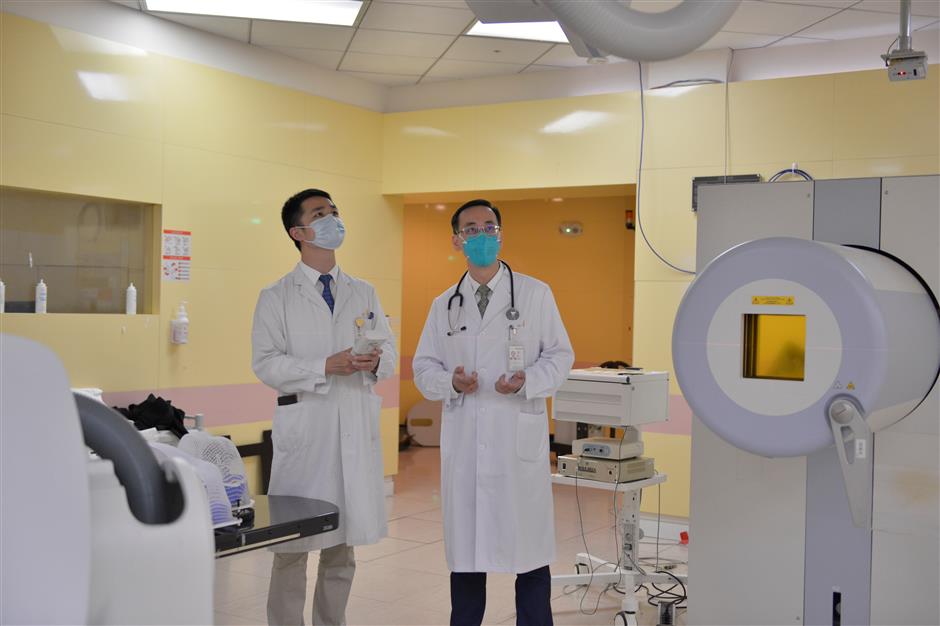Renowned medical scientist makes history in cancer treatment
When asked about his preferred language for an interview, Dr Jiade J. Lu smiled and said, “I can do it best in Shanghai dialect.”
Then he went on to recommend the best camera angle to capture the spacious greenery around the Shanghai Proton and Heavy Ion Center, where Lu serves as executive vice president.
Lu is a Chinese-American clinical oncology expert. As a child in Shanghai, he used to visit the Pudong area on the east shore of the Huangpu River. At the time, Pudong could be reached only by ferry and was mostly paddy fields.
Today it is the gleaming face of modern Shanghai, with its soaring skyscrapers, Oriental Pearl TV Tower, vast parklands and home to the “Wall Street of China.”
“It is a very modern city now,” he said. “When I visited as a child, it was farmland. I remember there was a small park, but no modern buildings, no high-rises.”
He also remembers seeing TV news about a grand master plan for developing Pudong when he was in the US. Four years later, Lu saw the new area in its earliest stages on a visit back to his hometown.
In the ensuing three decades, Lu worked in the US and Singapore but always tried to return to Shanghai at least once a year. Year by year, Pudong was dramatically changing. One by one, skyscrapers rose.
Little did he know that he would one day become a “new Pudong’er” — a term he doesn’t particularly like. He was one of the earliest foreigners to obtain a residency permit in Shanghai and has twice won the city’s prestigious Magnolia Award — silver in 2017 and gold earlier this year.

A radiation treatment room at the Shanghai Proton and Heavy Ion Center
In 2014, when an opportunity arose for the construction of the world’s most advanced radiation treatment center for cancer patients, Lu’s decision to move back to his hometown was sealed.
“In my heart, I never left Shanghai,” he said. “My whole being is very strongly associated with the city.”
He now lives near the Pudong International Airport, which is convenient for both his medical work and his trips abroad.
“The majority of my time currently is spent in Pudong,” he told Shanghai Daily. “There is really no difference now between Pudong and Puxi, except we have newer buildings here.”
Lu has more than just childhood memories linking him to Pudong. His wife comes from the family of Tao Guisong (1879-1956), a legendary carpenter-turned-construction magnate whose projects included the historic Art Deco Majestic Theater and the Bank of China on the Bund.
The Tao family compound in Pudong was built in 1930. Lu and his wife still visit the old site, which now has been renovated to include a variety of restaurants and shops.
We are sitting in the lobby of the hospital’s therapy section. Lu proudly lists the center’s achievements in the five years since it opened. It has treated more than 3,000 patients with proton and heavy ion therapy.
Lu said the success rate with those patients is higher than for those at the same stages of cancer who receive conventional radiation treatment therapy.

Lu (right) at work at the Shanghai Proton and Heavy Ion Center
His latest research was published in the medical journal Cancer in March, presenting comparative results and data of patients with glioblastoma multiforme, a very aggressive form of cancer that starts in the brain.
“About one-third of patients diagnosed with the disease are in China,” Lu explained. “Usually these patients, with or without surgery, need radiation treatment. The medium survival time of our patients with proton and heavy ion therapy is about 30 percent longer. These results are relatively preliminary and need further study to confirm, but they shed light on further improvement in treating this malignant disease and for providing patients with a better quality of life.”
His colleagues in the US have approached Lu for collaborative research because there is no comparable facility there yet.
“Proton and heavy ion therapy is considered the most advanced and precise way of giving radiation therapy to cancer patients,” Lu said. “When we started this medical service in 2015, there were only three hospitals in the world that had both proton and heavy ion facilities. Now five years later, it is still very advanced.”
He added, “Colleagues in Europe and the US mostly use only proton therapy. We work very closely and support each other, especially in clinical research. It’s great that we can provide this service not only to patients from Shanghai, but also to people from other parts of China. We have a few patients from the US, Singapore, Spain and Malaysia.”

A model of the radiation therapy section of the hospital
Lu’s other expertise lies in head and neck cancer, and particularly in throat and larynx cancer. The Chinese call the latter the “cancer of Canton” because it is so prevalent in southern China.
“Our therapy is the most important treatment for this disease,” Lu said. “We have treated a lot of patients who didn’t respond to previous radiation therapy. This is a group that needs particular attention. Their treatment in conventional radiation therapy usually fails because of the very bad side effects or because of local recurrence.”
Such science and technology developments are what Lu anticipates for Pudong moving ahead.
“I think new development will not only be infrastructure,” he said. “In the next 10 years, we will see more development in the content of Pudong — quality rather than quantity, in-depth rather than superficial.”

















